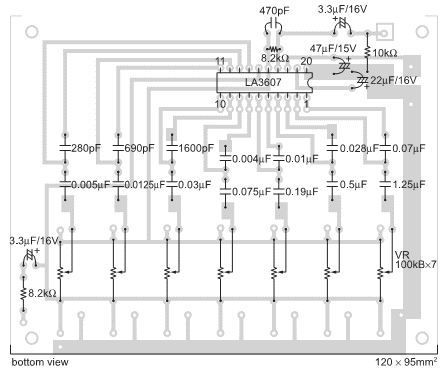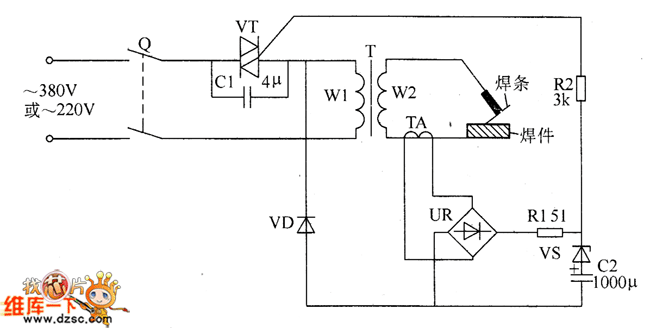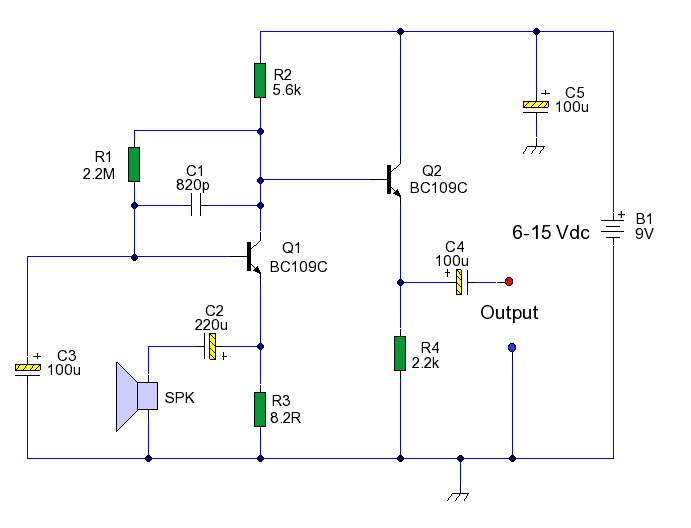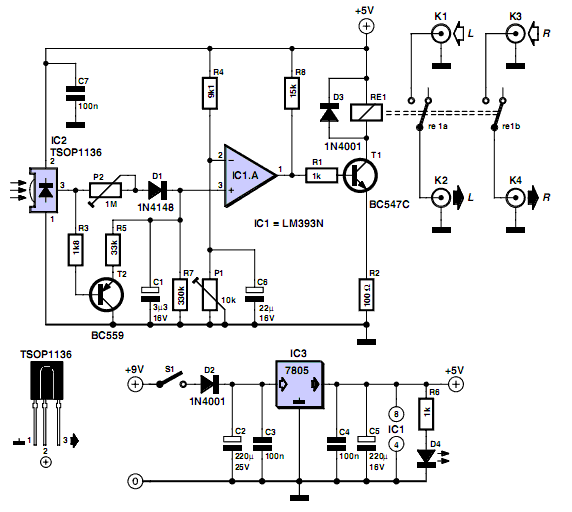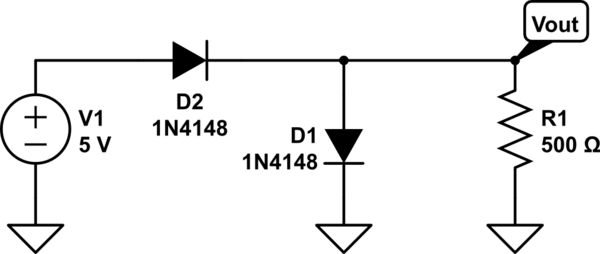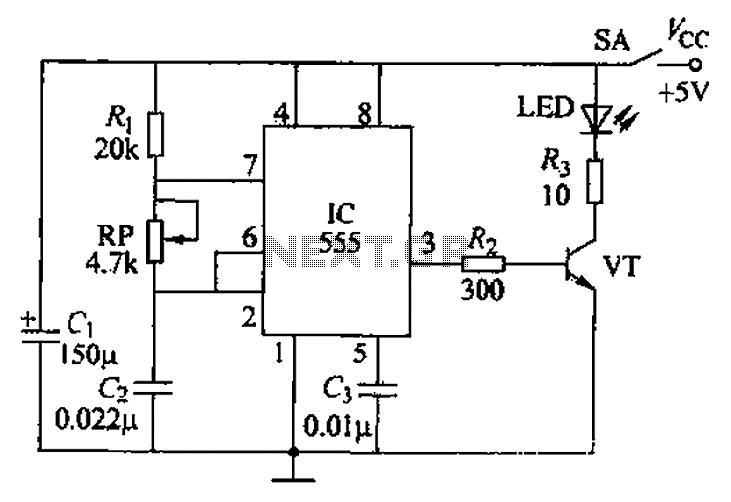
5V Dial Tone Circuit Circuit
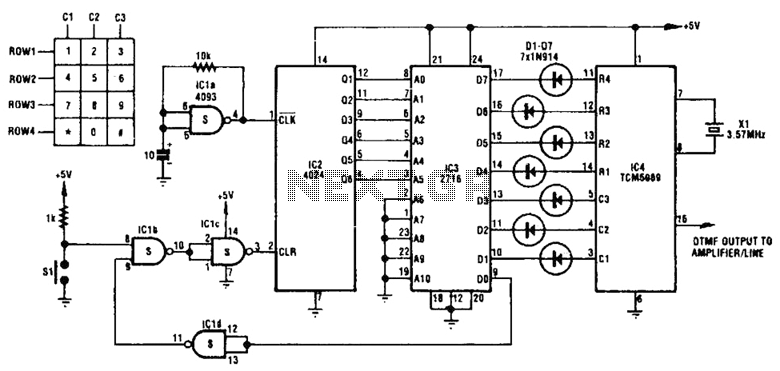
This circuit utilizes inexpensive, commonly available components to generate a precise dial tone for telephone applications. The Intel 82C54 timer-counter (U1) produces square wave signals at frequencies of 350 Hz and 440 Hz, which are subsequently filtered by resistors and capacitors (R1/C1 and R3/C2). These filtered signals are then mixed together using resistors R2 and R4. An operational amplifier is configured as a 395 Hz, Sallen-Key, second-order bandpass filter, which is positioned between the 350 Hz and 440 Hz signals to eliminate unwanted harmonic signals.
The circuit design employs a versatile timer-counter that can be substituted with various models, provided they produce square wave outputs in the desired frequency range. This flexibility allows for the incorporation of different timer-counter ICs, facilitating easy accessibility and cost-effectiveness in the design.
The 82C54 timer-counter serves as the primary frequency generator, producing two distinct square wave outputs at frequencies of 350 Hz and 440 Hz. These frequencies correspond to the standard frequency components of a telephone dial tone. The outputs from U1 are then passed through the filtering networks formed by R1/C1 and R3/C2, which smooth out the square waveforms into more sinusoidal shapes, reducing the presence of high-frequency noise and harmonics.
The mixed output from the filtering stage is combined using resistors R2 and R4, which effectively blend the two frequencies to create a composite signal. This mixed signal is then fed into an operational amplifier configured in a Sallen-Key topology, which serves as a bandpass filter centered at 395 Hz. This specific frequency is strategically chosen as it lies midway between the two original frequencies, allowing for optimal tone generation while attenuating any unwanted frequencies outside the intended passband.
The use of a Sallen-Key filter configuration ensures that the output maintains a desirable amplitude and phase response, critical for maintaining the integrity of the dial tone. The operational amplifier amplifies the filtered signal to the required level for telephone line compatibility.
In summary, this circuit efficiently generates a precise dial tone using basic electronic components, ensuring that it can be easily replicated and modified for various applications within telecommunications. The design's reliance on standard components enhances its accessibility for hobbyists and professionals alike, making it a practical solution for generating telephone tones. This circuit uses inexpensive, common components to generate a precise dial tone for phone applications (see the figure). Ul (an Intel 82C54 timer-counter) generates 350 and 440Hz square waves that are filtered by Rl/Cl and R,JC2, and mixed together by resistors R2 and R4.
An operational amplifier configured as a 395-Hz, Sallen-Key, second-order bandpass filter (halfway between 350 and 440 Hz) removes unwanted signal harmonics. Almost any timer-counter can be used as the signal source, so long as it produces roughly square-wave outputs. 🔗 External reference
The circuit design employs a versatile timer-counter that can be substituted with various models, provided they produce square wave outputs in the desired frequency range. This flexibility allows for the incorporation of different timer-counter ICs, facilitating easy accessibility and cost-effectiveness in the design.
The 82C54 timer-counter serves as the primary frequency generator, producing two distinct square wave outputs at frequencies of 350 Hz and 440 Hz. These frequencies correspond to the standard frequency components of a telephone dial tone. The outputs from U1 are then passed through the filtering networks formed by R1/C1 and R3/C2, which smooth out the square waveforms into more sinusoidal shapes, reducing the presence of high-frequency noise and harmonics.
The mixed output from the filtering stage is combined using resistors R2 and R4, which effectively blend the two frequencies to create a composite signal. This mixed signal is then fed into an operational amplifier configured in a Sallen-Key topology, which serves as a bandpass filter centered at 395 Hz. This specific frequency is strategically chosen as it lies midway between the two original frequencies, allowing for optimal tone generation while attenuating any unwanted frequencies outside the intended passband.
The use of a Sallen-Key filter configuration ensures that the output maintains a desirable amplitude and phase response, critical for maintaining the integrity of the dial tone. The operational amplifier amplifies the filtered signal to the required level for telephone line compatibility.
In summary, this circuit efficiently generates a precise dial tone using basic electronic components, ensuring that it can be easily replicated and modified for various applications within telecommunications. The design's reliance on standard components enhances its accessibility for hobbyists and professionals alike, making it a practical solution for generating telephone tones. This circuit uses inexpensive, common components to generate a precise dial tone for phone applications (see the figure). Ul (an Intel 82C54 timer-counter) generates 350 and 440Hz square waves that are filtered by Rl/Cl and R,JC2, and mixed together by resistors R2 and R4.
An operational amplifier configured as a 395-Hz, Sallen-Key, second-order bandpass filter (halfway between 350 and 440 Hz) removes unwanted signal harmonics. Almost any timer-counter can be used as the signal source, so long as it produces roughly square-wave outputs. 🔗 External reference
Warning: include(partials/cookie-banner.php): Failed to open stream: Permission denied in /var/www/html/nextgr/view-circuit.php on line 713
Warning: include(): Failed opening 'partials/cookie-banner.php' for inclusion (include_path='.:/usr/share/php') in /var/www/html/nextgr/view-circuit.php on line 713
